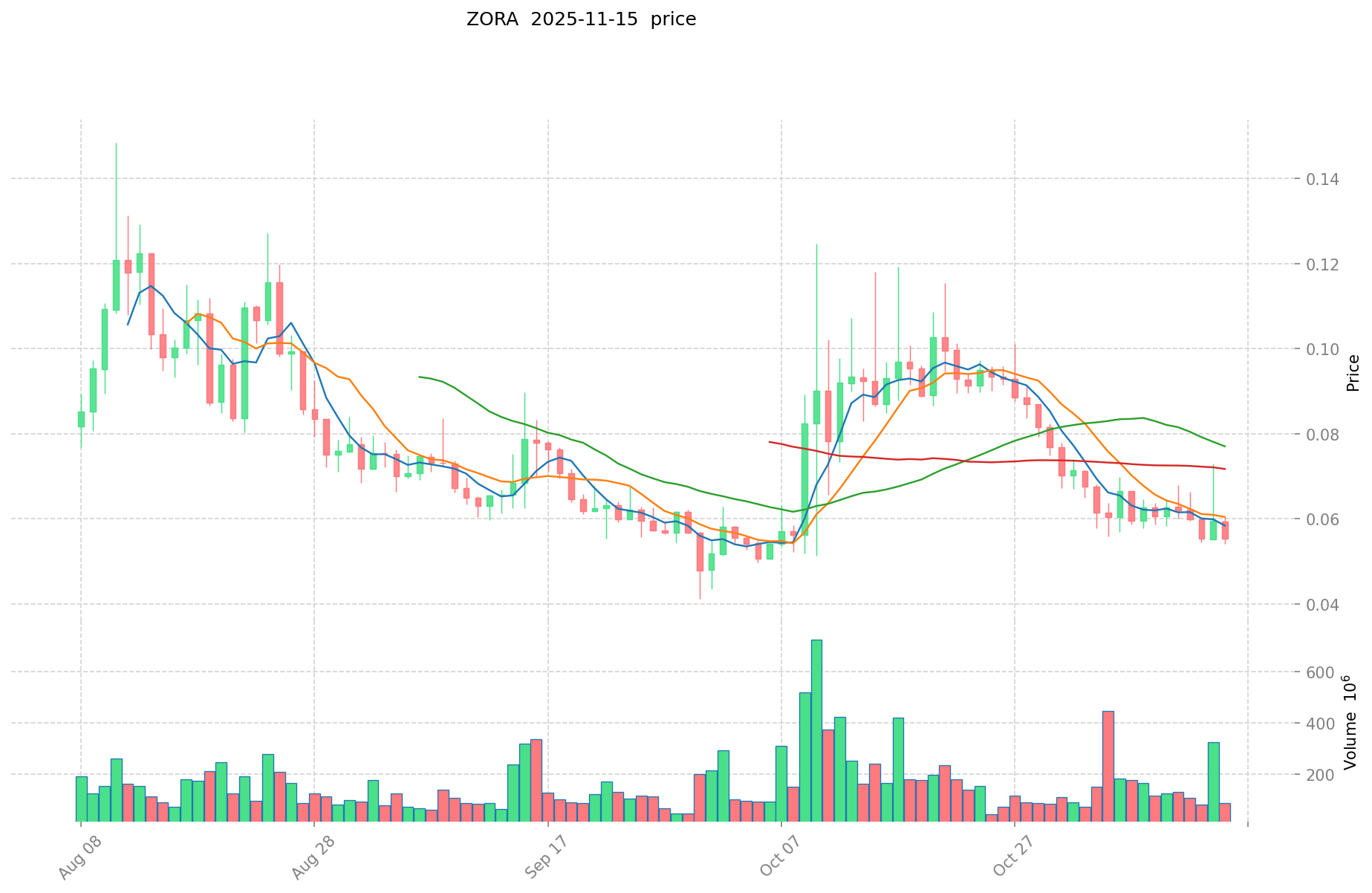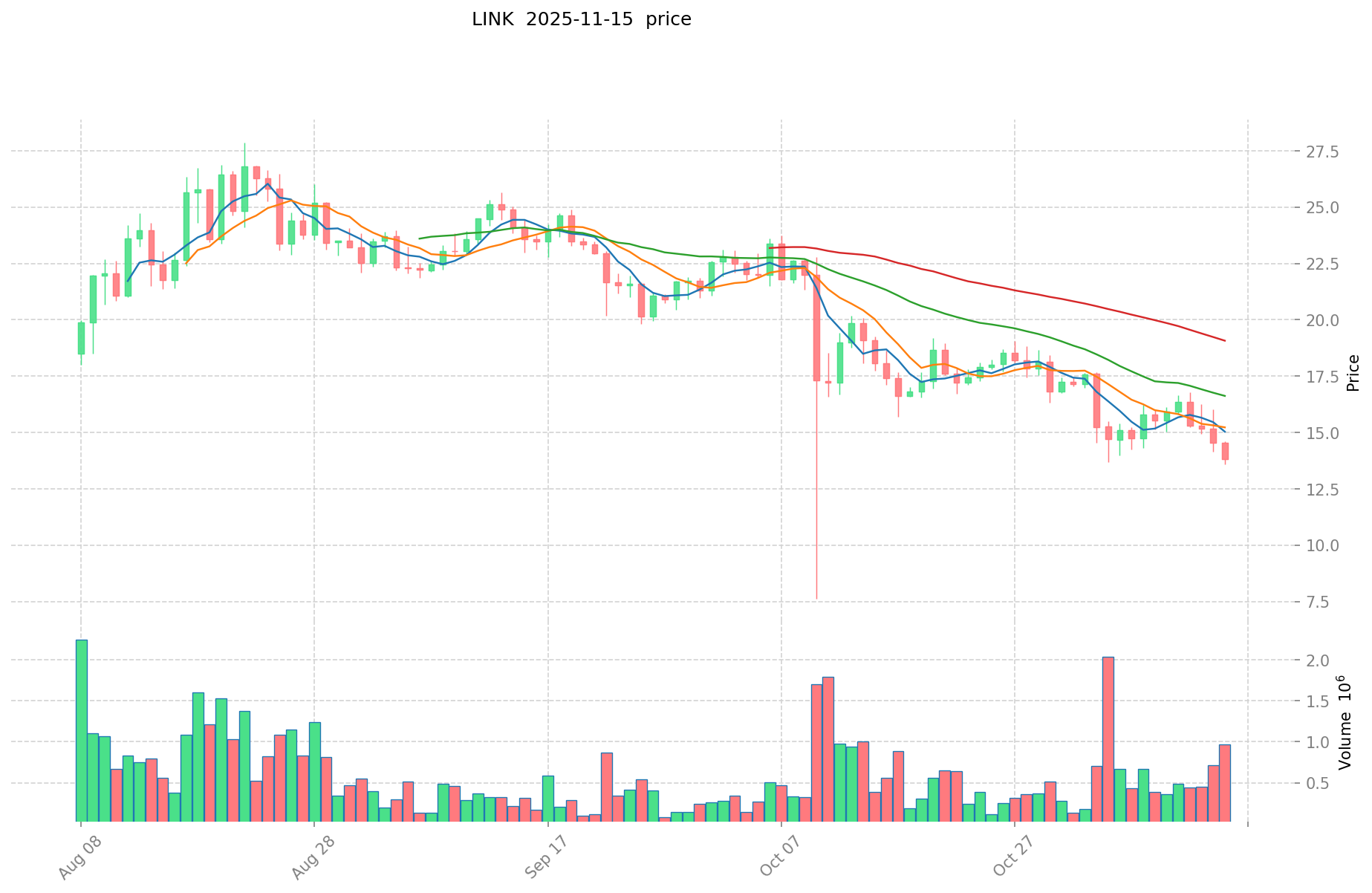ZORA vs LINK: A Battle of Blockchain Protocols for the Future of Digital Content
Introduction: ZORA vs LINK Investment Comparison
In the cryptocurrency market, the comparison between ZORA and LINK has always been a topic that investors can't ignore. The two not only show significant differences in market cap ranking, application scenarios, and price performance, but also represent different positions in crypto assets.
Zora (ZORA): Since its launch, it has gained market recognition for helping creators turn into tradable tokens and empowering users to "own attention".
ChainLink (LINK): Since 2017, it has been hailed as a decentralized oracle network, and is one of the cryptocurrencies with the highest global trading volume and market capitalization.
This article will provide a comprehensive analysis of the investment value comparison between ZORA and LINK, focusing on historical price trends, supply mechanisms, institutional adoption, technological ecosystems, and future predictions, attempting to answer the question that investors care about most:
"Which is the better buy right now?"
I. Price History Comparison and Current Market Status
ZORA (Coin A) and LINK (Coin B) Historical Price Trends
- 2025: ZORA reached its all-time high of $0.148437 on August 11, 2025, and its all-time low of $0.007755 on June 18, 2025.
- 2021: LINK reached its all-time high of $52.7 on May 10, 2021, while its all-time low was $0.148183 on November 29, 2017.
- Comparative Analysis: In the recent market cycle, ZORA has shown significant volatility, with a price range between $0.007755 and $0.148437. LINK, on the other hand, has demonstrated long-term stability and growth, maintaining a price well above its all-time low from 2017.
Current Market Situation (2025-11-16)
- ZORA current price: $0.052009
- LINK current price: $14.093
- 24-hour trading volume: ZORA $2,735,471.02 vs LINK $3,484,370.91
- Market Sentiment Index (Fear & Greed Index): 10 (Extreme Fear)
Click to view real-time prices:
- View ZORA current price Market Price
- View LINK current price Market Price


II. Core Factors Affecting the Investment Value of ZORA vs LINK
Supply Mechanism Comparison (Tokenomics)
- ZORA: Inflationary tokenomics with a total supply of 1 billion tokens, featuring two-week emission periods and a community treasury for long-term funding.
- LINK: Fixed supply of 1 billion tokens with 800 million in circulation, using a deflationary burning mechanism through transaction fees.
- 📌 Historical pattern: LINK's deflationary mechanism has historically supported price stability, while ZORA's emission-based model may create short-term selling pressure.
Institutional Adoption and Market Applications
- Institutional holdings: LINK has stronger institutional backing with major funds and exchanges holding positions, while ZORA is earlier in its institutional adoption cycle.
- Enterprise adoption: LINK dominates in real-world data applications across multiple industries including banking and insurance, while ZORA focuses specifically on creative industries and cultural applications.
- Regulatory attitudes: LINK enjoys clearer regulatory status across jurisdictions, while ZORA's governance model may face regulatory scrutiny in certain markets.
Technical Development and Ecosystem Building
- ZORA technical upgrades: Implementing creator tooling and supporting a creator-focused ecosystem with NFT minting innovations and customizable frameworks.
- LINK technical development: Expanding Cross-Chain Interoperability Protocol (CCIP) and scaling solutions for secure oracle networks across multiple blockchains.
- Ecosystem comparison: LINK has established deep integration across DeFi protocols as the dominant oracle solution, while ZORA specializes in the cultural and creative NFT ecosystem with less widespread adoption.
Macroeconomic and Market Cycles
- Performance in inflationary environments: LINK has shown better correlation with traditional tech investments during inflation, while ZORA lacks historical data for comparison.
- Macroeconomic monetary policy: Interest rates and USD index fluctuations impact LINK more directly due to its wider institutional adoption and market capitalization.
- Geopolitical factors: LINK's critical infrastructure role in multiple blockchains provides resilience during market uncertainty, while ZORA's more specialized use case may limit its utility during cross-border disruptions.
III. 2025-2030 Price Prediction: ZORA vs LINK
Short-term Prediction (2025)
- ZORA: Conservative $0.039039 - $0.052052 | Optimistic $0.052052 - $0.05361356
- LINK: Conservative $10.48432 - $14.168 | Optimistic $14.168 - $18.70176
Mid-term Prediction (2027)
- ZORA may enter a growth phase, with prices expected between $0.04012649641 - $0.077016985045
- LINK may enter a steady growth phase, with prices expected between $14.554729728 - $19.169644032
- Key drivers: Institutional investment inflow, ETF developments, ecosystem growth
Long-term Prediction (2030)
- ZORA: Base scenario $0.089485743683085 - $0.096644603177732 | Optimistic scenario $0.096644603177732 - $0.105622517134134
- LINK: Base scenario $21.219375969792 - $23.55350732646912 | Optimistic scenario $23.55350732646912 - $25.90885805911603
Disclaimer: The above predictions are based on historical data and market analysis. Cryptocurrency markets are highly volatile and subject to rapid changes. These projections should not be considered as financial advice. Always conduct your own research before making investment decisions.
ZORA:
| 年份 | 预测最高价 | 预测平均价格 | 预测最低价 | 涨跌幅 |
|---|---|---|---|---|
| 2025 | 0.05361356 | 0.052052 | 0.039039 | 0 |
| 2026 | 0.076607531 | 0.05283278 | 0.0295863568 | 1 |
| 2027 | 0.077016985045 | 0.0647201555 | 0.04012649641 | 24 |
| 2028 | 0.075829370191575 | 0.0708685702725 | 0.037560342244425 | 36 |
| 2029 | 0.105622517134134 | 0.073348970232037 | 0.050610789460105 | 41 |
| 2030 | 0.096644603177732 | 0.089485743683085 | 0.06353487801499 | 72 |
LINK:
| 年份 | 预测最高价 | 预测平均价格 | 预测最低价 | 涨跌幅 |
|---|---|---|---|---|
| 2025 | 18.70176 | 14.168 | 10.48432 | 0 |
| 2026 | 19.0644608 | 16.43488 | 13.3122528 | 16 |
| 2027 | 19.169644032 | 17.7496704 | 14.554729728 | 25 |
| 2028 | 22.1515886592 | 18.459657216 | 15.50611206144 | 30 |
| 2029 | 22.133129001984 | 20.3056229376 | 18.478116873216 | 43 |
| 2030 | 23.55350732646912 | 21.219375969792 | 11.6706567833856 | 50 |
IV. Investment Strategy Comparison: ZORA vs LINK
Long-term vs Short-term Investment Strategies
- ZORA: Suitable for investors focused on creative industries and NFT ecosystem potential
- LINK: Suitable for investors seeking stability and integration with traditional finance
Risk Management and Asset Allocation
- Conservative investors: ZORA: 10% vs LINK: 90%
- Aggressive investors: ZORA: 30% vs LINK: 70%
- Hedging tools: Stablecoin allocation, options, cross-currency portfolio
V. Potential Risk Comparison
Market Risk
- ZORA: Higher volatility due to lower market cap and newer tokenomics
- LINK: Susceptible to broader crypto market trends and DeFi sector performance
Technical Risk
- ZORA: Scalability, network stability in early stages
- LINK: Oracle network reliability, potential smart contract vulnerabilities
Regulatory Risk
- Global regulatory policies may have different impacts on both, with LINK potentially facing less scrutiny due to its established position
VI. Conclusion: Which Is the Better Buy?
📌 Investment Value Summary:
- ZORA advantages: Strong potential in creative and cultural markets, innovative NFT applications
- LINK advantages: Established market position, wide adoption in DeFi, proven track record
✅ Investment Advice:
- Novice investors: Consider a higher allocation to LINK for stability
- Experienced investors: Balanced approach with both ZORA and LINK based on risk tolerance
- Institutional investors: LINK for established infrastructure play, ZORA for exposure to emerging creative markets
⚠️ Risk Warning: The cryptocurrency market is highly volatile. This article does not constitute investment advice. None
VII. FAQ
Q1: What are the main differences between ZORA and LINK in terms of tokenomics? A: ZORA has an inflationary tokenomics model with a total supply of 1 billion tokens and two-week emission periods. LINK, on the other hand, has a fixed supply of 1 billion tokens with 800 million in circulation and uses a deflationary burning mechanism through transaction fees.
Q2: How do ZORA and LINK compare in terms of institutional adoption? A: LINK has stronger institutional backing with major funds and exchanges holding positions, while ZORA is earlier in its institutional adoption cycle. LINK also has wider enterprise adoption across multiple industries, whereas ZORA focuses specifically on creative industries and cultural applications.
Q3: What are the key technical developments for ZORA and LINK? A: ZORA is implementing creator tooling and supporting a creator-focused ecosystem with NFT minting innovations. LINK is expanding its Cross-Chain Interoperability Protocol (CCIP) and scaling solutions for secure oracle networks across multiple blockchains.
Q4: How do the price predictions for ZORA and LINK compare for 2030? A: For ZORA, the base scenario predicts $0.089485743683085 - $0.096644603177732, with an optimistic scenario of $0.096644603177732 - $0.105622517134134. For LINK, the base scenario predicts $21.219375969792 - $23.55350732646912, with an optimistic scenario of $23.55350732646912 - $25.90885805911603.
Q5: What are the recommended asset allocations for ZORA and LINK? A: For conservative investors, a suggested allocation is 10% ZORA and 90% LINK. For aggressive investors, the recommendation is 30% ZORA and 70% LINK.
Q6: What are the main risks associated with investing in ZORA and LINK? A: ZORA faces higher volatility due to its lower market cap and newer tokenomics, as well as potential scalability and network stability issues. LINK is susceptible to broader crypto market trends and DeFi sector performance, with potential risks in oracle network reliability and smart contract vulnerabilities.
Q7: Which token is considered a better buy for different types of investors? A: Novice investors may consider a higher allocation to LINK for stability. Experienced investors might take a balanced approach with both ZORA and LINK based on risk tolerance. Institutional investors may prefer LINK for established infrastructure play and ZORA for exposure to emerging creative markets.
Share
Content